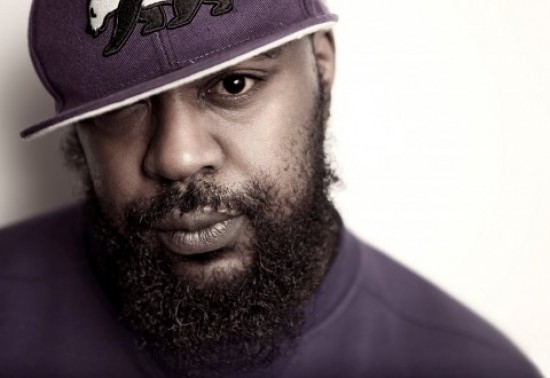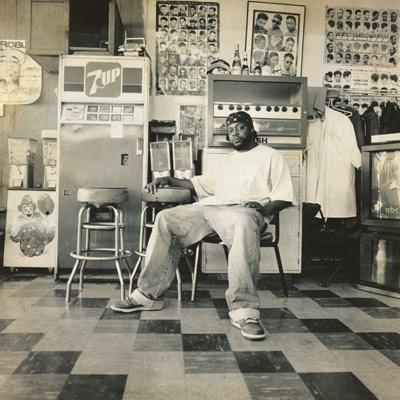Guilty Simpson
Guilty Simpson was born in Detroit, the son and grandson of the family’s performing musicians in his father and grandfather. At age four, Simpson and his mother began traveling with an aunt in the military, living in California and Birmingham, Alabama, before settling back in the Motor City at 15. Big Daddy Kane, N.W.A, and Scarface were all major influences, but it was Queens-bred street bard Kool G Rap who made the biggest impression. “That’s my crème de la crème rapper right there,” says Simpson, his own presence among the latest in a rich lineage of heavy-handed MCs.
For years Guilty Simpson has been a rock on the Detroit hip-hop circuit alongside those such as J Dilla, Slum Village, Eminem (whom Guilty still calls “Marshall”) & D12, Obie Trice, Proof, Phat Kat and Black Milk. A member of the Almighty Dreadnaughtz crew, Guilty emerged as a sound to be reckoned with after linking with producer Dilla in 2001. In the midst of recording an album’s worth of material on the MC – including the recently released duet “Take Notice” off of Dilla’s heralded Ruff Draft album – Dilla gave Simpson his first appearance on disc with “Strapped” (from 2003’s Jaylib album).
2006 marked his allegiance with Stones Throw Records – at Dilla’s behest – and appearances on both Chrome Children installments and subsequent tour. It’s taken years, but finally Simpson’s full-length solo debut, Ode to the Ghetto, brings him worldwide, chronicling a life led in the rough-hewn city that birthed him.
Featuring an all-star cast of producers normally reserved for those signed to six-figure deals (J Dilla, Madlib, Denaun Porter of D-12), Ode to the Ghetto marks an evolution, incorporating a more topical and thought-provoking persona in addition to the extra-savage braggadocio Simpson is known for. “I want to make the consumer care about the music again,” the 31-year-old explains.
Guilty’s testosterone-charged, inner city themes possess of a sense of humor at times so side-splitting, it only proves how serious he really is. This rapper was raised on the field of battle and he has more to say than just how fresh he is and how fresh “they” are not. As a matter of fact, he’s found that he’s here to remind the hip-hop world – currently captivated with that manufactured freshness – that life in the ghetto is real.
The evidence shows excessive use of double entendres, too much flavor on public grounds, microphone assault, and verbal harassment of an officer of the law. On the counts of freshness AND realness: The Court of Hip-Hop finds Mr. Simpson to be Guilty.
Sean Price
You wanna know what rap is? Sean Price is what rap is, period. He is a stand-out member of the Boot Camp Clik, one half of Heltah Skeltah, part of the group Random Axe and a major solo artist by himself with more than lots to show for.
With Heltah Skeltah and Boot Camp Clik, he released the albums “Nocturnal”, “Magnom Force”, “For The People”, The Chosen Few”, “The last Stand” and “D.I.R.T.”. His 2005 solo debut “Money Bars” was followed by his album “Jesus Price Supastar” in 2007 on Duck Down Music. Hip Hop purists have long recognized and appreciated Sean’s commanding delivery, powerful voice and clever verses and all of those attributes are on full-display with ‘Jesus Price Supastar.
In 2009 Sean Price teamed up with Guilty Simpson and Black Milk to create one of the rawest hip-hop supergroups in recent years, Random Axe. They released their self-titled debut, ‘Random Axe’ June 2011. The album was critically acclaimed and well recieved by fans for its hard hitting production provided by Black Milk and fierce, witty rhymes provided by Sean Price and Guilty Simpson.
In 2009 Sean Price also released a mixtape entitled “Kimbo Price” which served as a prelude to P’s new album ‘Mic Tyson” that dropped in 2012. And on “Mic Tyson”, he doesn’t miss a beat, giving out gems like “that hardcore rapping is played out, until I hardcore slap you then ask you what’s played out?” on “Price & Shining Armor.” Sean P murders it, and if you like raw rap the way it should be, this is where you will get it.
Black Milk
As the buzz of many of hip hop’s young leaders-to-be evolves from loud commotion into hushed whispers, Black Milk has stayed relevant by remaining focused on creating music that endures. He’s achieved recognition from fans, critics, and his peers as one of the best producers around, and when coupling that talent with his sharp lyricism and stylish delivery as an emcee, Black has proven to be one of the most vital hip hop artists of his generation.
This is already clear to those who heard his 2008 album Tronic, which capped a successful and astonishingly prolific year (in which he also released collaborative full-length releases with rappers Bishop Lamont and Fat Ray, as well as producing the acclaimed solo album from Slum Village’s Elzhi). Tronic showcased a growth in production technique that few expected from a beatmaker best-known for chopping samples, as his signature drums were now peppered with live instrumentation and richer arrangements.
2009 looked to be another year of tremendous progress for Black Milk’s career. After touring Europe with his newly-formed band, consisting of drummer Daru Jones and keyboardist/singer AB, he returned home to Detroit ready to launch efforts on his next album. The year took an unexpected turn as his mentor Baatin of Slum Village–who Black credits with launching his professional career–suddenly passed away. Only weeks later, Black’s manager HexMurda fell into a coma and was paralyzed with a rare pontine stroke. The quick succession of these events eerily mirrored the abrupt deaths of Detroit legends J Dilla and Proof in 2006, stunning the close-knit hip hop community in the Motor City. Things only got worse for Black as he dealt with additional deaths within his family over the next few months. 2009 had become the most difficult year of his life.
As the year came to a close, he returned to recording, and announced that his next release would be audaciously titled Album of the Year. Black quickly explained that the title was referring to the course of events from the previous 12 months. Many fans and critics discounted that explanation, expressing either excitement or objection that he was brashly proclaiming that his work would be the year’s best before the year had even started.
Far from a melancholic work, Album of the Year once again sees Black Milk working to break new ground in hip hop production, and to both refine and redefine his sound. While continuing to construct the skeletons of the tracks on his same trusted AKAI MPC-2000 XL that he’s been using for years, he now employs a team of studio musicians and session players to add new layers of fat and muscle to his songs, with most of the players’ parts composed by the artist himself. A broad range of influence shines through in the tracks, with tinges of rock, reggae, and afrobeat joining his trademark hip hop bangers.
Other than the heavy contributions from both members of his live band (vocalist/keyboardist AB and drummer Daru Jones), the album exclusively features players and vocalists from his hometown of Detroit, including vocalist Melanie Rutherford, bassist Tim Shellabarger, and the versatile horn player and string arranger Sam Beaubien (who arranged horns and strings on Mayer Hawthorne’s A Strange Arrangement). The few guest raps are provided by Royce Da 5’9″, Elzhi, and newcomer Danny Brown.
Few artists in hip hop are able to create music that can rise above expectations and defy categorization. Black Milk welcomes the challenge to accomplish what others cannot, and he’s doing it not only with his acclaimed recordings but also with an electrifying live show. Performing with Daru and AB, the tracks are taken to another level on stage. Both Album of the Year and exciting live performances across the globe are sure to elevate Black Milk that much closer to the star status many have predicted.





